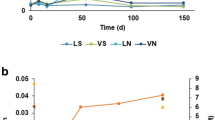Abstract
The generation of hydrogen sulfide in a reservoir can be characterized by a massive influx of organic matter, manifest thermal stratification, and an extreme anoxic state specifically at the hypolimnion layer in summer. It has been reported that in this deep layer of a thermally stratified water body, where dissolved oxygen is depleted and redox potential falls sharply below the value of zero, the prolonged oxygen-free period and negative redox potential may potentiate the production of toxic hydrogen sulfide. The main aim of this study was to simulate the varying concentration of hydrogen sulfide at the deepest part of the reservoir based on intensive monitoring of water quality parameters. A one-dimensional hydraulic ecosystem model was applied to simulate vertical distribution of dissolved oxygen (DO) continuously in time. Based on the simulated DO, the length of continuous oxygen-free state in the deepest layer was specified and then utilized to estimate the temporal changes of oxidation–reduction potential (ORP) using a polynomial regression model. Finally, a linear regression model for hydrogen sulfide was fitted from the observed ORP, based on which, the temporal changes of hydrogen sulfide concentration were modeled using the simulated ORP. The introduction of several calculations gave good simulated results of hydrogen sulfide concentration, and this approach can be considered useful for predictive and explanatory purposes in further research investigating toxic hydrogen sulfide at the hypolimnion of the reservoir.













Similar content being viewed by others
References
Carla MK, Andrew M, Ryan JS, Christine S (2012) Redox stratification and salinization of three kettle lakes in Southwest Michigan, USA. Water Air Soil Pollut 223:1415–1427
Dake JMK, Harleman DRF (1969) Thermal stratification in lakes: analytical and laboratory studies. Water Resour Res 5:484
Dunnette DA, Chynoweth DP, Mancy KH (1985) The source of hydrogen sulfide in anoxic sediment. Water Res 19:875–884
Harada M, Hiramatsu K, Saitoh T, Mori M, Marui A (2009) Dynamics of water qualities in a eutrophic water body under scarce underwater light environment. J Rainwater Catchment Syst 14:87–96
Henderson-Sellers B (1985) A simple formula for vertical eddy diffusion coefficients under conditions of nonneutral stability. J Geophys Res 87:5860
Herlihy AT, Mills AL (1985) Sulfate reduction in freshwater sediments receiving acid mine drainage. Appl Environ Microbiol 49:179–186
Kent WT, Bruce LK, Forrest EP (1990) Anonymous reservoir limnology. Wiley, Canada
Kondo J, Yasuhiro S, Tetsuo I (1979) On wind-driven current and temperature profiles with diurnal period in the oceanic planetary boundary layer. J Phys Oceanogr 9:360
Luther G, Glazer B, Ma S, Trouwborst R, Shultz B, Druschel G, Kraiya C (2003) Iron and sulfur chemistry in a stratified lake: evidence for iron-rich sulfide complexes. Aquat Geochem 9:87–110
Mortimer CH (1941) The exchange of dissolved substances between mud and water in lakes. J Ecol 29:280–329
Smith LL, Donavon MO, Ira RA, Stven JB (1976) Effect of hydrogen sulfide on fish and invertebrates. EPA, Waterloo Wind Farm
Stumm W, Morgan JJ (1973) Aquatic chemistry an introduction emphasizing chemical equilibria in natural waters. 1970, 583 S. Wiley, New York, London, Sydney, Toronto, p 117
Zerkle AL, Kamyshny A Jr, Kump LR, Farquhar J, Oduro H, Arthur MA (2010) Sulfur cycling in a stratified euxinic lake with moderately high sulfate: constraints from quadruple S isotopes. Geochim Cosmochim Acta 74:4953–4970
Acknowledgments
This research was partly supported by a JSPS Grant-in-Aid for Scientific Research (B) (Project number: 19380138) and the Kyushu University New Campus Planning Office.
Author information
Authors and Affiliations
Corresponding author
Rights and permissions
About this article
Cite this article
Thuy Do, N., Yoshimura, Y., Harada, M. et al. Generation of hydrogen sulfide in the deepest part of a reservoir under anoxic water conditions. Paddy Water Environ 13, 101–113 (2015). https://doi.org/10.1007/s10333-013-0412-0
Received:
Revised:
Accepted:
Published:
Issue Date:
DOI: https://doi.org/10.1007/s10333-013-0412-0




